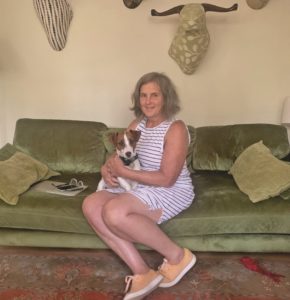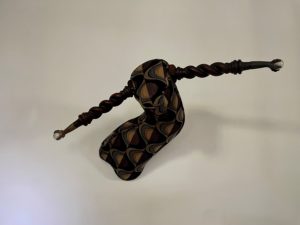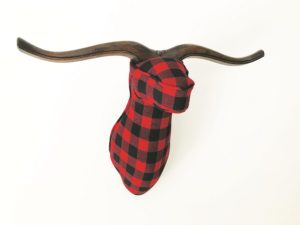In her Truro home, the sculptor Breon Dunigan bends to calm her lively puppy while four of her majestic horned “trophy heads” observe the scene silently from above. “Much of my work is about taking something that has had a life and giving it another new life,” she says.
The animalistic sculptures are a new twist on a body of work she has been doing for years. A selection of Dunigan’s “trophy heads” — alongside works by Mark Adams, Stephanie Sassoon, Vicky Tomayko, and Rebecca Doughty — will be on view at Provincetown’s Schoolhouse Gallery in a show opening this Friday, Sept. 3.

“It brings me great joy to work with Breon for so many reasons, personal to professional,” says gallerist Mike Carroll. “There is particular satisfaction in presenting work by a woman artist who employs mastery, accuracy, humor, and reference to make moments in material culture that are unexpected and beautiful.”
Dunigan has lived full time on the Outer Cape for the past 26 years. In 2005, she and her husband, Bob Bailey, also a sculptor, founded the gallery artSTRAND with eight other artists. Since artSTRAND disbanded in 2016, Dunigan has been active at the Provincetown Art Association and Museum, where she is on the exhibitions committee and curates shows. “It’s always exciting to get more intimate with an artist and their process,” she says.
Dunigan created her first “trophy head” while in graduate school at the Mason Gross School of the Arts at Rutgers in 1983. “I had a dream about an amorphous shape coming out at me,” she recalls. She created a sculpture resembling an enormous animal head and neck shaped in resin with a wild crop of straw hair. She began to work on a series of wooden heads, including a deer-shaped one “in the throes of death.”

Eventually, Dunigan says, her interests evolved into examining “people’s attachment to objects and why somebody might hang a trophy head on their wall but would never own a sculpture.” She pauses, then turns the question onto itself: “And what’s the difference between a trophy and a work of art? Art can be seen as kind of trophy, in the sense of ‘Look what I’ve got.’ ”
Dunigan spent her childhood summers in Provincetown and Truro where her mother grew up. She didn’t encounter hunting trophies until traveling as a young adult. As a child, “I would have been more likely to see a fish on someone’s wall,” she says, laughing.
While there weren’t any hunters in her family, there were plenty of artists. Dunigan’s grandfather was the painter Philip Malicoat, who came to Provincetown to study with Charles Webster Hawthorne at the Cape Cod School of Art. Her mother was Martha Malicoat Dunigan and her uncle, Conrad Malicoat, both renowned Provincetown artists.

Dunigan’s mother became one of her first formal sculpture teachers at the University of North Carolina School of the Arts. “I was always a maker, and sculpture came naturally to me,” Dunigan says. She went on to attend the Atlanta College of Art and MassArt before earning her M.F.A. from Rutgers.
After abandoning her trophy heads in the early 1990s — “I felt at the time that I had made the perfect head, so I moved on” — Dunigan began “pouring pieces out of plaster that started with vessels and other objects that were cluttering up my life,” she says. While continuing to work in plaster to this day, she returned to making trophy heads around 2010.
“I felt like I was going back to an early place,” Dunigan says. “But how I make the heads now is technologically much more difficult.” Each head is built like a complex piece of furniture with curves and bends that involve the careful stretching of patterned fabric over carved wood. The horns are made of reclaimed table and chair legs with intricate arcs and twists.
Dunigan draws inspiration from a variety of horned creatures. “Some of my trophy heads are more deer-like, others take on aspects of an antelope, a water buffalo, or a goat,” she says. “I have one at the gallery now called Golden Fleece that is very sheepy, using circular parts from an old rocking chair.”

Friends and family appear at Dunigan’s doorstep with abandoned furniture. Some, she says, don’t “feel like they are finished with their current life yet,” so she waits to tear them up. When she cannot find the right piece, Dunigan admits, “I get desperate, and I’ll go hunting” — by which she means searching in thrift stores and on the sides of roads for furniture ready to be reanimated.
The textiles Dunigan uses are also reclaimed when possible. “I have a hard time throwing certain things away,” she says. “One of the fabrics I made artwork from last year was a wool shirt my mother had since high school. I had to make the decision: do I cut this up? It was really hard, but I did it.
“My mother used to say, ‘To live and breathe is to create,’ ” Dunigan continues. “And it was just like that. Everybody around her was pursuing a creative endeavor, and everyone was supporting one another.”
Animal Magnetism
The event: Works by Breon Dunigan
The time: Friday, Sept. 3 through Sept. 26
The place: Schoolhouse Gallery, 494 Commercial St., Provincetown
The cost: Free



